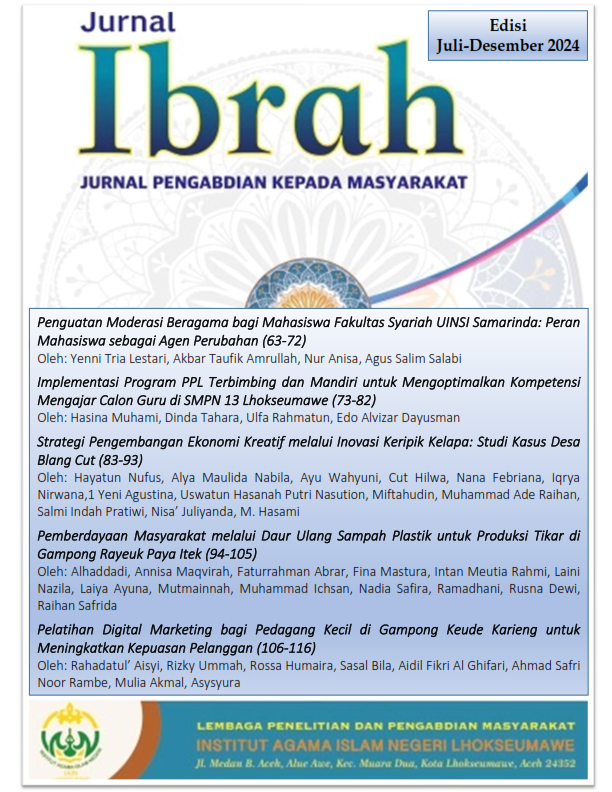Pemberdayaan Masyarakat melalui Daur Ulang Sampah Plastik untuk Produksi Tikar di Gampong Rayeuk Paya Itek
DOI:
https://doi.org/10.47766/ibrah.v3i2.4838Keywords:
Community Empowerment, Plastic Waste Management, Recycled MatsAbstract
This research aims to empower the community of Gampong Rayeuk Paya Itek through the management of plastic waste into economic value products in the form of mats. The research objectives include improving community skills in recycling plastic waste, increasing awareness of the importance of waste management, and developing an online marketing network for craft products. The research used a participatory qualitative approach with the Participation action research (PAR) method through observation, training, and mentoring integrated in a 3R-based empowerment program (Reduce, Reuse, Recycle). Data was collected through interviews and documentation. The results showed the success of this program in environmental, social, and economic aspects. A total of 45 kg of plastic waste was successfully managed, creating a cleaner environment and increasing community awareness of the importance of recycling. Socially, the housewives' skills improved in processing plastic waste into mats, strengthening collaboration between residents, and creating positive synergy with student participation. The economic impact is in the form of additional income through the sale of mats for Rp25,000-Rp30,000 per piece, as well as wider market access through social media. The program also encourages sustainability through community commitment to continue production, continued training support from the village government, and community-based business development plans. The implications of the research include an effective community empowerment model in overcoming plastic waste problems, improving community welfare, and contributing to the literature on local empowerment-based plastic waste management.
References
Bowen, G. A. (2009). Document Analysis as a Qualitative Research Method. Qualitative Research Journal, 9(2), 27–40. https://doi.org/10.3316/QRJ0902027.
Bronfenbrenner, U. (1979). The Ecology of Human Development. Cambridge: Harvard University Press.
Creswell, J. W. (2016). Research Design: Qualitative, Quantitative, and Mixed Methods Approaches (4th ed.). Sage Publications.
Etzkowitz, H., & Leydesdorff, L. (2000). The Dynamics of Innovation: From National Systems and “Mode 2” to a Triple Helix of University–Industry–Government Relations. Research Policy, 29(2), 109–123. https://doi.org/10.1016/S0048-7333(99)00055-4.
Friedmann, J. (1992). Empowerment: The Politics of Alternative Development. Blackwell Publishers.
Jambeck, J. R., Geyer, R., Wilcox, C., Siegler, T. R., Perryman, M., Andrady, A., & Law, K. L. (2015). Plastic Waste Inputs from Land into The Ocean. Science, 347(6223), 768-771. https://doi.org/10.1126/science.1260352.
Kotler, P., & Keller, K. L. (2016). Marketing Management. 15th Edition. Pearson Education.
Kvale, S., & Brinkmann, S. (2009). Interviews: Learning the Craft of Qualitative Research Interviewing (2nd ed.). Sage Publications.
Lestari, P., & Trihadiningrum, Y. (2019). The impact of Improper Solid Waste Management to Plastic Pollution in Indonesian Coastal Environment. Marine Pollution Bulletin, 149, 110505. https://doi.org/10.1016/j.marpolbul.2019.110505.
Mandrysz, W. (2020). Community-based social economy–social capital and civic participation in social entrepreneurship and community development. Management Dynamics in the Knowledge Economy, 8(1), 81-93. https://www.ceeol.com/search/article-detail?id=943796.
Miles, M. B., Huberman, A. M., & Saldaña, J. (2014). Qualitative Data Analysis: A Methods Sourcebook (3rd ed.). Sage Publications.
Ndiung, S., Nurtati, R., Jenimantris, Y., Eni, B. L., & Mulianti, E. (2022). Pelatihan Pengolahan Sampah Plastik Menjadi Produk Kreatif Bernilai Ekonomis. Jurnal Kreativitas Pengabdian Kepada Masyarakat (PKM), 5(3), 849-855. https://doi.org/10.33024/jkpm.v5i3.5394.
Sachs, J. D. (2015). The Age of Sustainable Development. Columbia University Press.
Saridera, I. (2018). Pemberdayaan Masyarakat Muslim Berbasis Lingkungan. Anida (Aktualisasi Nuansa Ilmu Dakwah), 18(1), 41-60. https://doi.org/10.15575/anida.v18i1.5045.
Shukla, A., & Kumar, A. (2019). Community-Based Plastic Waste Management: Case Studies and Strategies. Journal of Environmental Studies, 14(3), 213–225. https://www.ijmsssr.org/paper/IJMSSSR00586.pdf.
Sintiawati, N., Hilmi, M. I., & Setyaningsih, S. W. (2022). Strategi Pemberdayaan Masyarakat Melalui Pelatihan Pengolahan Limbah Plastik Bagi Ibu-Ibu PKK. https://repository.unej.ac.id/xmlui/handle/123456789/111052.
Sugiyono. (2018). Metode Penelitian Pendidikan: Pendekatan Kuantitatif, Kualitatif, dan R&D. Bandung: Alfabeta.
Sulaksono, J. (2020). Peranan digital marketing bagi usaha mikro, kecil, dan menengah (umkm) desa tales kabupaten kediri. Generation Journal, 4(1), 41-47. https://doi.org/10.29407/gj.v4i1.13906.
Downloads
Published
Issue
Section
License
Copyright (c) 2024 Alhaddadi, Annisa Maqvirah, Faturrahman Abrar, Fina Mastura, Intan Meutia Rahmi, Laini Nazila, Laiya Ayuna, Mutmainnah, Muhammad Ichsan, Nadia Safira, Ramadhani

This work is licensed under a Creative Commons Attribution-ShareAlike 4.0 International License.











